

Content analysis - what is content analysis? Content analysis is a method for summarizing any form of content by counting various aspects of the content.
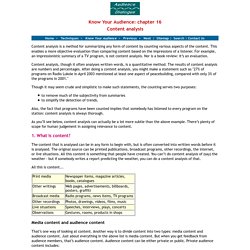
This enables a more objective evaluation than comparing content based on the impressions of a listener. For example, an impressionistic summary of a TV program, is not content analysis. Nor is a book review: it’s an evaluation. Content analysis, though it often analyses written words, is a quantitative method. The results of content analysis are numbers and percentages. Though it may seem crude and simplistic to make such statements, the counting serves two purposes: to remove much of the subjectivity from summaries to simplify the detection of trends. Also, the fact that programs have been counted implies that somebody has listened to every program on the station: content analysis is always thorough. As you’ll see below, content analysis can actually be a lot more subtle than the above example. An overview of content analysis. Stemler, Steve. Steve StemlerYale University Content analysis has been defined as a systematic, replicable technique for compressing many words of text into fewer content categories based on explicit rules of coding (Berelson, 1952; GAO, 1996; Krippendorff, 1980; and Weber, 1990).
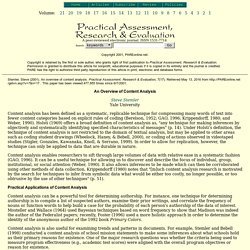
Holsti (1969) offers a broad definition of content analysis as, "any technique for making inferences by objectively and systematically identifying specified characteristics of messages" (p. 14). Under Holsti’s definition, the technique of content analysis is not restricted to the domain of textual analysis, but may be applied to other areas such as coding student drawings (Wheelock, Haney, & Bebell, 2000), or coding of actions observed in videotaped studies (Stigler, Gonzales, Kawanaka, Knoll, & Serrano, 1999). In order to allow for replication, however, the technique can only be applied to data that are durable in nature. Content analysis: Introduction.
Content analysis: Introduction Content analysis is a technique for systematically describing written, spoken or visual communication.
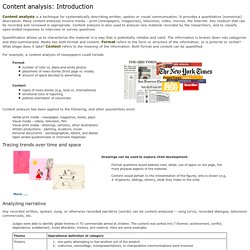
It provides a quantitative (numerical) description. Many content analyses involve media - print (newspapers, magazines), television, video, movies, the Internet. Any medium that can be recorded and reviewed is appropriate. Content analysis is also used to analyze new material recorded by the researchers, and to classify open-ended responses to interview or survey questions.
Quantification allows us to characterize the material in a way that is potentially reliable and valid. Content Analysis Introduction. CA. Content Analysis Methodology & Prominent Scholars. Queen’s University Andrevski’s research interests include competitive dynamics, strategic entrepreneurship and alliance networks.
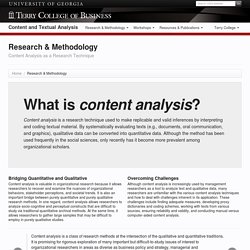
He uses a content analysis approach to examine competitive aggressiveness and entrepreneurial behavior of firms over time. University of Illinois Bednar's research focuses on corporate governance and executive leadership. He has used content analysis to measure the tone of media coverage and to examine how the media can serve as a governance mechanism and in some cases, prompt firm action. University of Alberta Deephouse used content analysis to examine the social evaluations of business organizations, specifically the legitimacy and reputation of Twin Cities commercial banks, the reputation of accounting firms, and stakeholder-specific evaluations of Wal-Mart. Boston College Jones’ research interests focus on cultural frameworks, cultural meaning and social structures.
Imperial College London Northwestern University Towson University. Reducing Confusion about Grounded Theory and Qualitative Content Analysis. Software for content analysis and text analysis: Qualitative analysis. Annotations for Mac Mac software to analyse documents by adding and organising highlights, tags or notes on text passages.
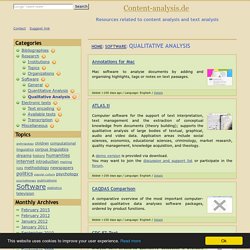
ATLAS.ti Computer software for the support of text interpretation, text management and the extraction of conceptual knowledge from documents (theory building); supports the qualitative analysis of large bodies of textual, graphical, audio and video data. Content Analysis. Writing@CSU Guide This guide provides an introduction to content analysis, a research methodology that examines words or phrases within a wide range of texts.
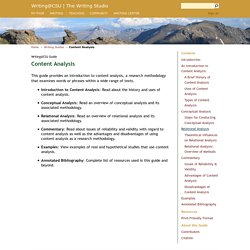
Three Approaches to Qualitative Content Analysis. Qualitative Content Analysis. Volume 1, No. 2, Art. 20 – June 2000 Qualitative Content Analysis Philipp Mayring.
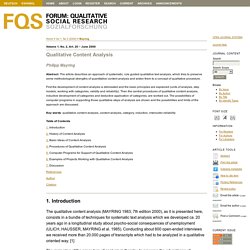
Methodology & Content analysis. Research Methods - Content Analysis. Content%20Analysis.%20A%20method%20of%20Social%20Science%20Research. 2007002122. 3. The ten steps of content analysis. The ten step of content analysis are: 1) Copy and read through the transcript - make brief notes in the margin when interesting or relevant information is found 2) Go through the notes made in the margins and list the different types of information found 3) Read through the list and categorise each item in a way that offers a description of what it is about 4) Identify whether or not the categories can be linked any way and list them as major categories (or themes) and / or minor categories (or themes) 5) Compare and contrast the various major and minor categories 6) If there is more than one transcript, repeat the first five stages again for each transcript 7) When you have done the above with all of the transcripts, collect all of the categories or themes and examine each in detail and consider if it fits and its relevance 8) Once all the transcript data is categorised into minor and major categories/themes, review in order to ensure that the information is categorised as it should be.
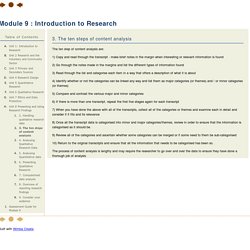
Research Methods - Content Analysis. Content Analysis: A Flexible Methodology. You are using an outdated version of Firefox which is not supported by ResearchGate anymore.
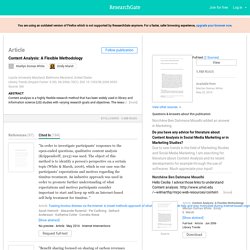
For a faster, safer browsing experience, upgrade your browser now. <div class="c-box-warning full-width-element" style="text-align: center; "><div style="margin: auto; padding:10px;" class="container"><b>For full functionality of ResearchGate it is necessary to enable JavaScript. Here are the <a href=" rel="nofollow" target="_blank"> instructions how to enable JavaScript in your web browser</a>. </b></div></div> Article Follow publication. ContentAnalysis.Nursing2016.